In the shadowy realm between dusk and darkness, a silent predator takes flight. With wings that cut through the air without a whisper and eyes that pierce the veil of night, the owl embodies nature’s perfect nocturnal hunter. Yet the most remarkable feature of this avian assassin isn’t its silent flight or its piercing gaze—it’s the distinctive facial disc that gives owls their characteristic appearance. This facial structure, often described as mask-like, represents millions of years of evolutionary engineering designed for one purpose: to make the owl a lethal hunting machine. Far from being merely decorative, an owl’s face is actually its greatest weapon—a sophisticated apparatus that enhances every aspect of its predatory lifestyle.
The Facial Disc: Nature’s Sound Parabola

The most distinctive feature of an owl’s face is its facial disc—a concave arrangement of specialized feathers that forms a dish-like structure around the eyes and beak. These stiff, dense feathers aren’t merely decorative; they serve as nature’s equivalent of a satellite dish, collecting and channeling sound waves directly to the owl’s ear openings. The facial disc works by reflecting sound waves like a parabolic reflector, effectively amplifying sounds that might otherwise be imperceptible. This remarkable adaptation allows owls to detect the faintest rustling of a mouse moving beneath leaves or snow, even from considerable distances. Research has shown that the facial disc can improve an owl’s hearing sensitivity by as much as 10 decibels—making sounds appear twice as loud as they would without this specialized structure.
Asymmetrical Ears: The Secret to Directional Hearing
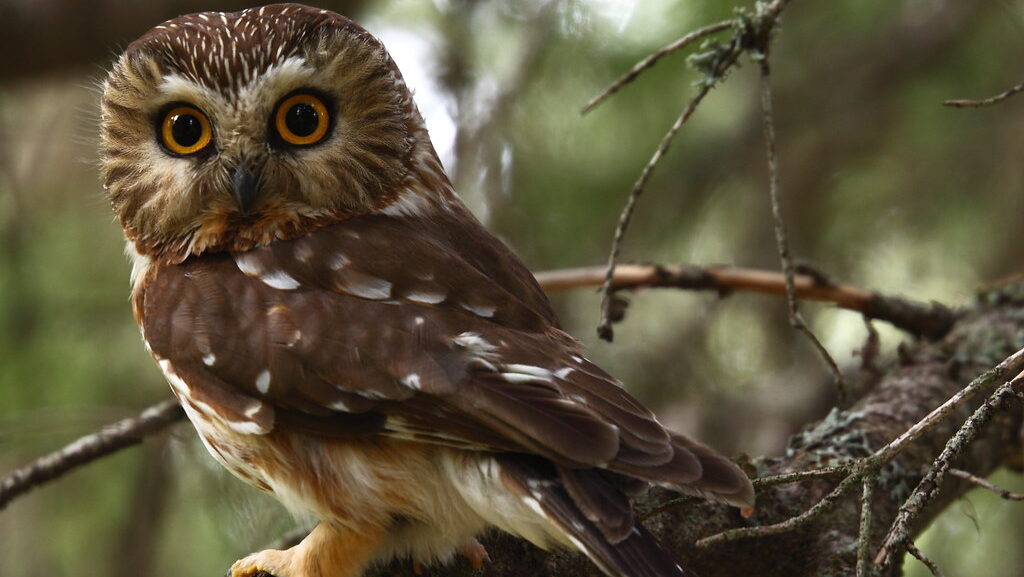
Hidden beneath the feathers of the facial disc lies another remarkable adaptation: asymmetrically positioned ear openings. Unlike humans and most other animals, an owl’s ear openings are positioned at different heights on either side of the head—one higher, one lower. This unusual arrangement creates a minuscule difference in the time it takes sound to reach each ear, providing the owl with precise three-dimensional acoustic information. When an owl detects prey, it can pinpoint the exact location with astounding accuracy—not just the direction, but also the distance and even the depth beneath snow or leaves. This remarkable ability is so precise that barn owls can strike prey in complete darkness, relying solely on acoustic information. The offset ears, working in concert with the facial disc, give owls the most accurate directional hearing of any animal tested.
The Eyes: Windows to a Different World
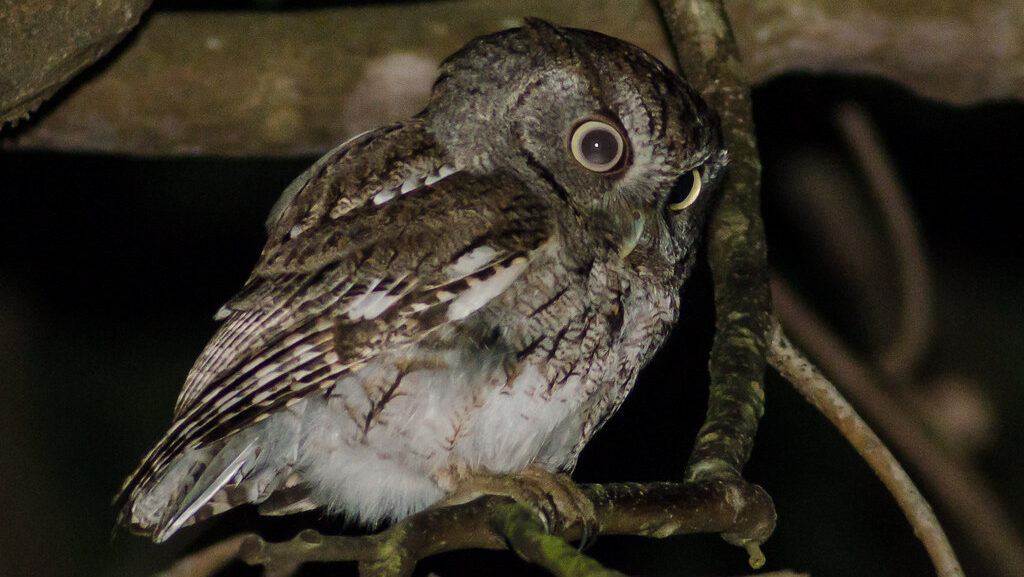
An owl’s eyes are perhaps its most striking feature—large, forward-facing, and seemingly all-knowing. These remarkable organs are not actually eyeballs but elongated tubes that are fixed in the skull, which is why owls must turn their entire head to change their field of view. The size of these eyes relative to the owl’s skull is extraordinary—in some species, the eyes occupy over 50% of the skull volume. This extraordinary size allows owls to gather available light with remarkable efficiency, giving them vision that’s estimated to be 100 times more sensitive than human vision in low-light conditions. The structure of the owl’s retina is specially adapted for night vision, with an abundance of rod cells that are sensitive to light but not color, prioritizing the ability to see in darkness over color perception. Additionally, many owl species possess a reflective layer behind the retina called the tapetum lucidum, which gives their eyes that characteristic glow while further enhancing their night vision capabilities.
The Head-Turning Ability: A 270-Degree Perspective
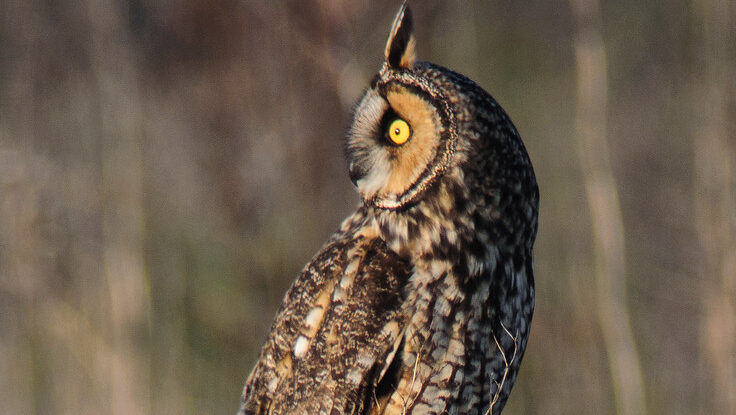
One of the most famous attributes of owls is their ability to rotate their heads nearly all the way around—up to 270 degrees in some species. This remarkable flexibility compensates for the owl’s fixed eye position and is made possible by specialized adaptations in the bird’s neck anatomy. Unlike humans, who have seven cervical vertebrae, owls possess fourteen, providing extraordinary rotational range. The owl’s circulatory system is specially adapted to prevent blood flow disruption during these extreme head movements, with enlarged vessels and small air pockets that ensure blood can reach the brain regardless of head position. This rotational ability works in concert with the facial disc and asymmetrical ears to create a sensory system that can track prey with pinpoint precision. The owl can effectively scan a wide area without moving its body, maintaining perfect stealth while its sensitive facial disc collects acoustic information from all directions.
The Beak: Hidden but Deadly
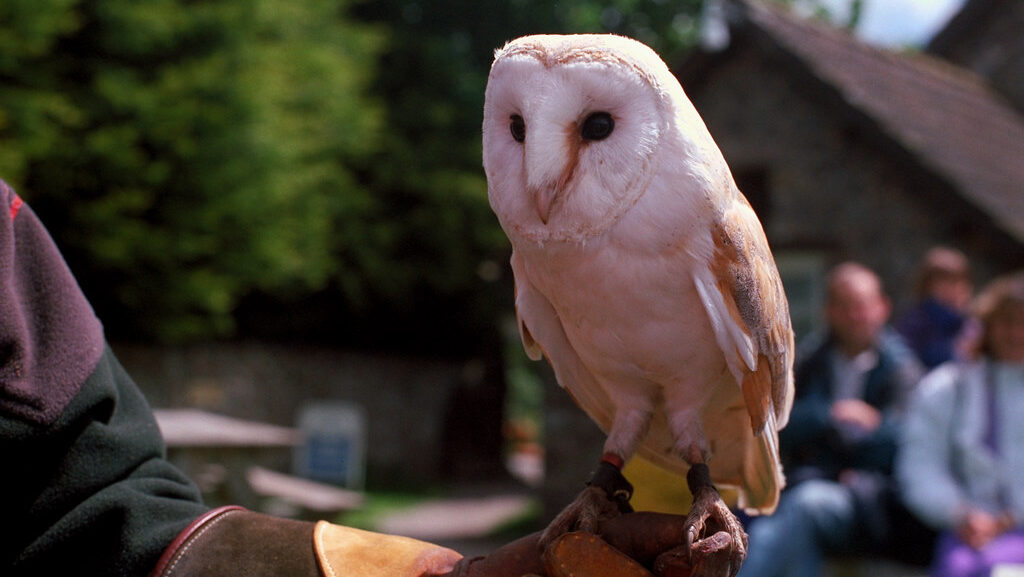
Partially obscured by the facial feathers, an owl’s beak is a lethal tool perfectly adapted for its predatory lifestyle. Unlike the prominently displayed beaks of eagles or hawks, the owl’s beak is relatively short and downward-curving, designed for tearing flesh rather than carrying prey over long distances. The beak’s position within the facial disc helps maintain the aerodynamic efficiency of the face while preserving the disc’s sound-collecting properties. In many owl species, the beak is nearly hidden among the specialized feathers, contributing to the bird’s distinctive appearance. Despite its concealed nature, the beak delivers tremendous force, capable of dispatching prey with a single, powerful bite. The shape and strength of the beak varies somewhat between species, reflecting differences in prey preference—from the robust beak of fish-eating species to the more delicate structure found in insectivorous owls.
Facial Feathers: The Acoustic Engineers
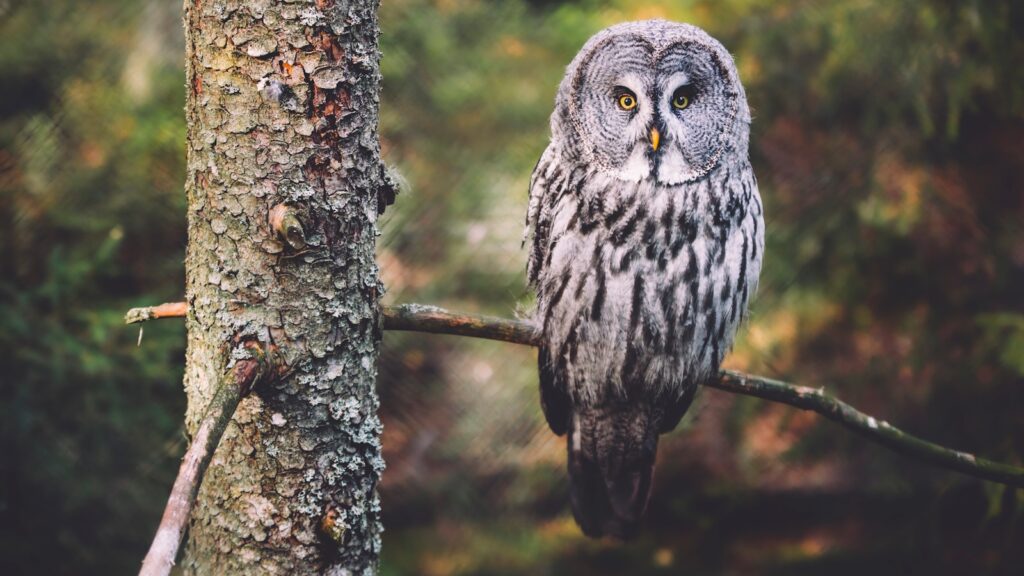
The specialized feathers that form an owl’s facial disc represent a marvel of natural engineering. These feathers differ significantly from those covering the rest of the owl’s body, with a dense, stiff structure that creates an effective acoustic surface. Microscopic examination reveals that facial disc feathers lack the barbules that give normal feathers their smooth appearance, resulting in a velvety texture that absorbs rather than reflects sound waves. This absorption prevents acoustic interference that might otherwise confuse the owl’s precise hearing. Different owl species show variations in facial disc development, with nocturnal hunters typically possessing more pronounced discs than their diurnal counterparts. The Great Grey Owl, considered to have the most acute hearing among owl species, possesses an exceptionally large and well-developed facial disc that extends well beyond the outline of its skull, enhancing its already remarkable auditory capabilities.
The Evolution of the Owl Face
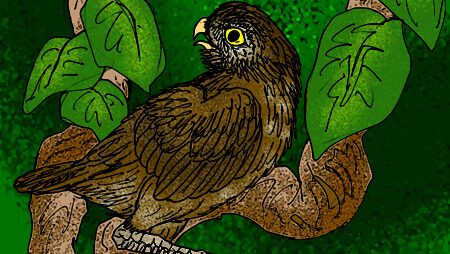
The distinctive facial structure of modern owls is the product of millions of years of evolutionary refinement, driven by the selective pressures of nocturnal hunting. Fossil evidence suggests that owl ancestors began developing specialized facial features as far back as 60 million years ago, during the early Paleogene period. This evolutionary journey coincides with the diversification of small mammals, suggesting that the owl’s facial adaptations evolved in response to the challenge of hunting small, fast-moving prey in low-light conditions. Comparative studies across different owl species reveal that the most pronounced facial discs are found in species that hunt in densely vegetated environments where visual cues are limited and acoustic information becomes paramount. The remarkable consistency of the facial disc across the 200+ species of owls, despite their global distribution and habitat diversity, testifies to the extraordinary effectiveness of this adaptation as a hunting tool.
Facial Expressions: The Emotional Mask

Despite their reputation for stoicism, owls possess a surprising range of facial expressions made possible by specialized muscles that control the feathers of the facial disc. These muscles allow owls to alter the shape of their facial disc in response to different situations and emotional states. When alert or threatened, an owl can flatten its facial disc, creating a stern, aggressive appearance that serves as a warning to potential threats. Conversely, when relaxed or curious, the facial disc assumes a more rounded, open configuration that gives the bird its characteristic “wise” appearance. These expressions play a crucial role in owl communication, particularly during courtship and territorial disputes. Researchers studying barn owls have identified at least seven distinct facial expressions, challenging the notion that birds are incapable of complex emotional displays.
Species Variations: Different Masks for Different Tasks

While all owls share the basic structure of the facial disc, remarkable variations exist across species, reflecting different hunting strategies and ecological niches. The heart-shaped face of the Barn Owl represents perhaps the most specialized adaptation, with an unusually large facial disc that gives this species the most acute directional hearing of any owl. By contrast, the Eagle Owl possesses a less pronounced facial disc but compensates with exceptionally large eyes that prioritize visual hunting. The diminutive Elf Owl of North American deserts features a compact facial disc suited to its insectivorous diet, while the fish-hunting Fishing Owl has water-resistant facial feathers that protect its acoustic system during underwater plunges. The Snowy Owl, which hunts in the perpetual daylight of Arctic summers, has a relatively reduced facial disc compared to strictly nocturnal species, reflecting its greater reliance on visual hunting techniques.
Hunting in Complete Darkness: The Ultimate Test

The true testament to the effectiveness of an owl’s facial adaptations is its ability to hunt successfully in conditions of total darkness. Laboratory experiments with barn owls have demonstrated that these birds can locate and capture prey in lightless environments with nearly the same efficiency as they do under normal conditions. Using only the acoustic information gathered by their facial disc and processed through their asymmetrical ears, owls can create a precise three-dimensional map of their surroundings. This remarkable ability allows them to navigate through complex environments, avoid obstacles, and strike prey with pinpoint accuracy—all without visual input. Field studies using infrared cameras have documented owls successfully hunting on moonless nights or in dense forests where light penetration is minimal, relying entirely on their extraordinary facial adaptations.
The Face as Camouflage: Hiding in Plain Sight
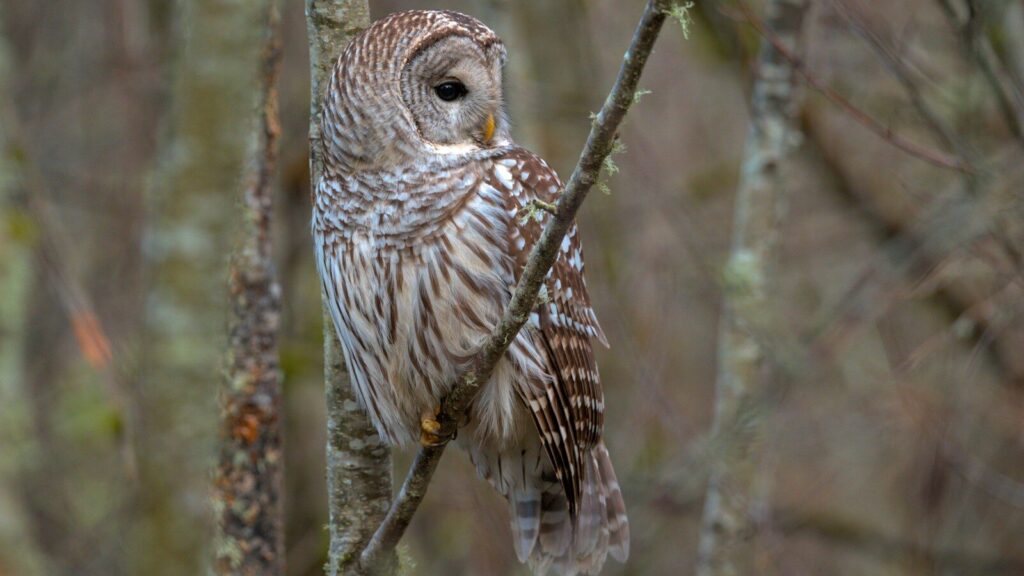
Beyond its acoustic functions, an owl’s facial structure also serves as sophisticated camouflage, helping the bird blend into its surroundings during daylight hours. The pattern of light and dark feathers across the facial disc breaks up the owl’s outline, making it harder to detect against the dappled background of trees and foliage. Many owl species can adjust their facial feathers to enhance this camouflage effect, flattening the facial disc to create a slimmer profile when trying to avoid detection. This camouflage function is particularly important for diurnal rest periods, when owls are vulnerable to mobbing by smaller birds that recognize them as predators. The facial camouflage works in concert with the owl’s overall plumage pattern, which typically mimics tree bark or foliage, creating a remarkably effective disguise that allows these predators to rest undisturbed despite their large size.
Cultural Perceptions: The Face That Launched a Thousand Myths

The distinctive facial structure of owls has captivated human imagination across cultures and throughout history, inspiring everything from reverence to fear. In Ancient Greece, the owl’s seemingly human-like face led to its association with Athena, goddess of wisdom, establishing the enduring connection between owls and intelligence. Conversely, many Native American tribes viewed the owl’s face as an omen of death or transformation, believing that the bird’s ability to see in darkness gave it access to the spirit world. In medieval Europe, the owl’s facial features were often interpreted as demonic, contributing to persecution and superstition. The ambivalent cultural response to owl faces continues today, with many people finding them simultaneously appealing and unsettling—a reaction psychologists attribute to the unique combination of familiar, almost human-like features arranged in decidedly non-human proportions. This phenomenon, known as the “uncanny valley” effect, may explain why owl faces feature so prominently in both children’s literature and horror films.
Conservation Implications: Protecting Nature’s Perfect Design

Understanding the extraordinary adaptations of an owl’s face has significant implications for conservation efforts worldwide. The highly specialized nature of these facial structures makes owls particularly vulnerable to environmental changes that affect their hunting efficiency. Light pollution, for instance, disrupts the advantage of the owl’s night vision adaptations, while habitat fragmentation interferes with the acoustic hunting facilitated by the facial disc. Conservation strategies increasingly recognize the need to preserve not just owl habitats but the specific conditions that allow their specialized facial adaptations to function effectively. Scientists are also studying owl facial structure to develop biomimetic technologies, from noise-canceling devices inspired by facial disc feathers to directional microphones based on the asymmetrical ear system. By protecting owls and their habitats, we preserve not only a magnificent example of evolutionary engineering but also a potential source of inspiration for future technological innovations.
Conclusion
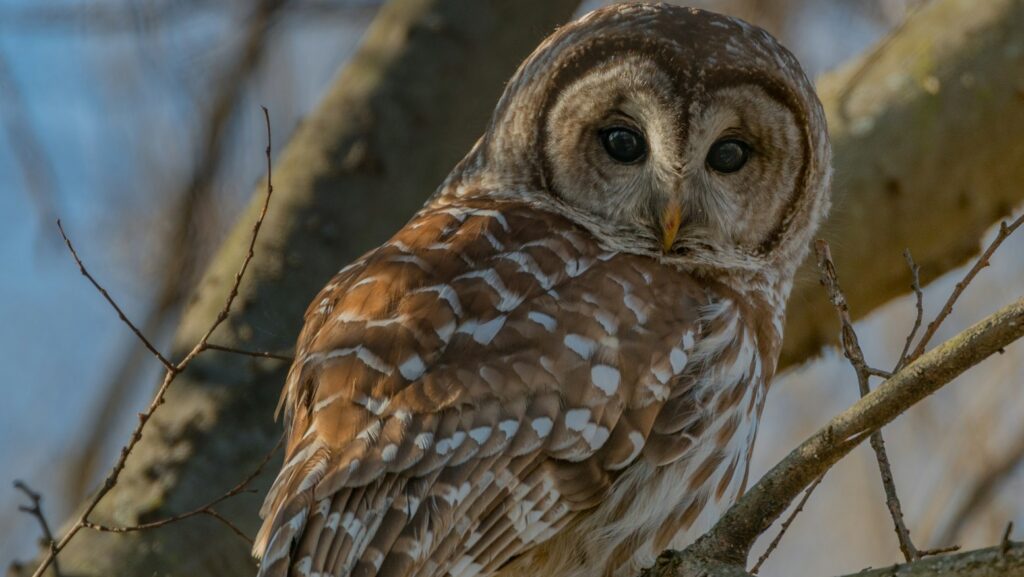
The owl’s face represents one of nature’s most remarkable examples of specialized adaptation—a complex integration of form and function refined over millions of years of evolution. Far more than just a distinctive appearance, the owl’s facial structure is a sophisticated weapon system that enables these birds to reign supreme as nocturnal predators. From the sound-gathering facial disc to the asymmetrical ears, from the night-vision eyes to the lethal beak, every element works in perfect harmony to create a hunting efficiency unmatched in the avian world. As we continue to study and understand these extraordinary adaptations, we gain not only scientific knowledge but also a deeper appreciation for the intricate perfection of natural design. Behind the mask of the owl lies not just a face, but a testament to the power of evolutionary adaptation—a living example of how specialized traits can create not just survival advantage, but absolute mastery of an ecological niche.
